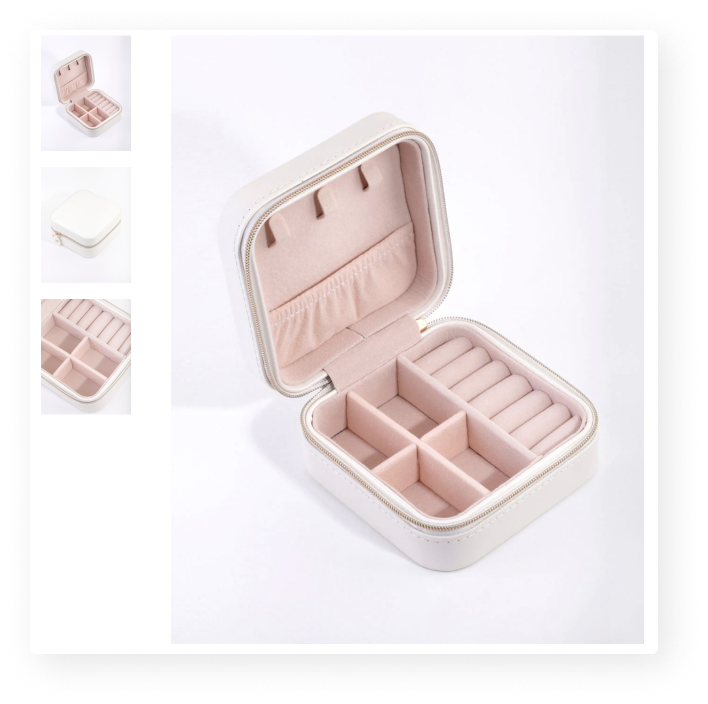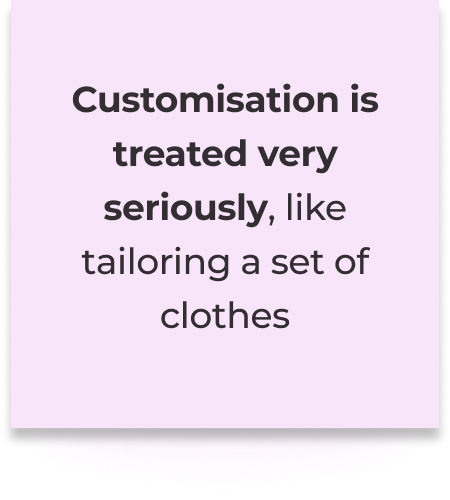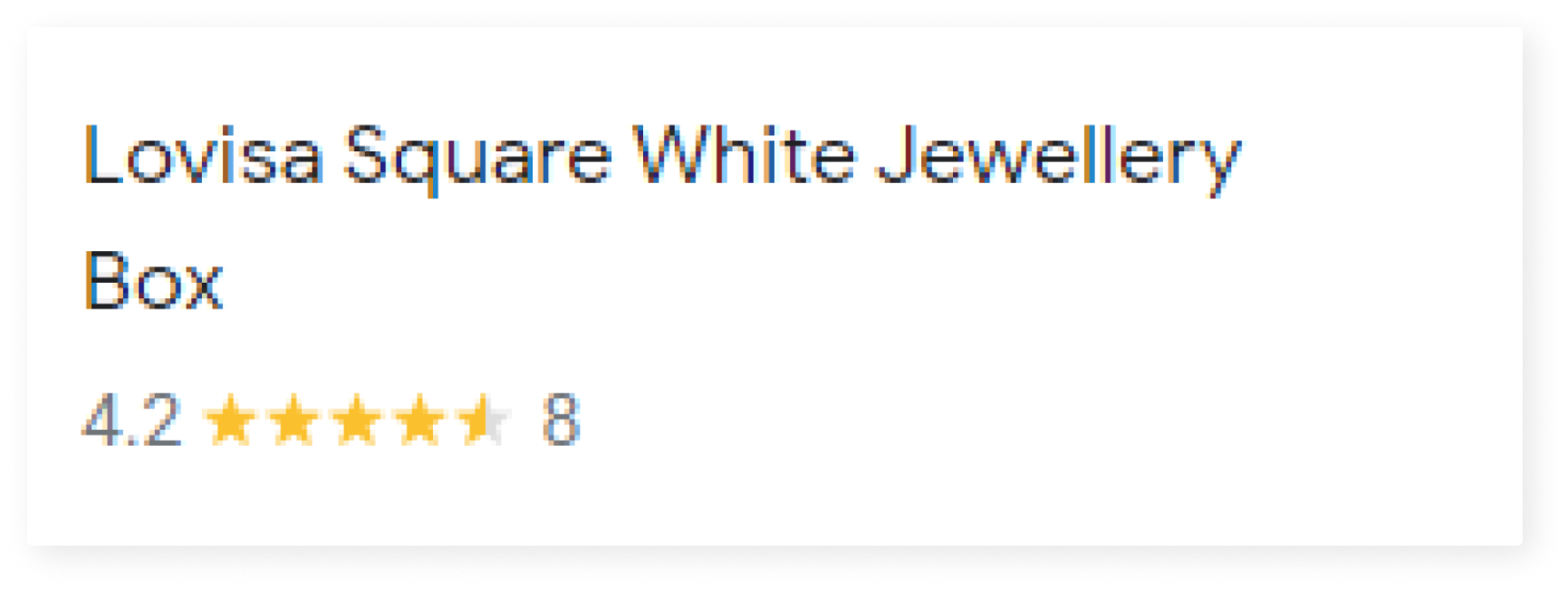
Vanayoh
MVP for an early-stage Luxury brand that sells luxury jewelry boxes online
UX / UI Design, Research 2022
Solution
The client was able to gain a clearer understanding of her target audience's preferences and expectations regarding jewelry storage boxes
The client is unsure about what potential customers look for in a jewelry storage box, such as the specific designs and features they value the most
Also, she wants to understand how she can effectively address the concerns of customers who are buying a luxury, higher-priced jewelry box online
Role
UX / UI designer
To understand what customers look for in a jewelry box through user research
To identify the profiles and behavior of potential customers that can be targeted by Vanayoh
To create wireframes of a home page and product page for Vanayoh
Project Objectives
Skills demonstrated
User Interviews, User Survey, Card Sorting, Competitive Analysis, Personas, Customer Journey Map, Affinity Mapping, Moodboard, Styleguide, Wireframing, Usability Testing, Prototyping
After conducting user research, we have established two distinct personas that accurately represent the potential customers of Vanayoh. These personas detail their preferences, needs, pain points, and behaviors as they relate to jewelry storage
Problem
Background
The client is in the process of developing a luxury brand, Vanayoh, that specializes in selling premium jewelry boxes online. At this stage of her business, she is exploring various ideas and assumptions about the type of jewelry boxes she could offer, as well as her target audience, which primarily comprises women aged 25 to 55. She seeks our help to better understand customer needs in jewelry storage and to design a website experience for her target audience
To address these customers' concerns about purchasing a luxury jewelry box online, we created an online shopping experience with a user-centered approach that prioritized the needs and preferences of the target audience. This involved developing a high-fidelity website prototype that provides an intuitive and user-friendly interface
Final presentation to our client
Understand
Competitor Analysis
To gain an understanding of Vanayoh's competitors, we analyzed 7 different brands and e-commerce websites spanning across low-end to high-end markets. Our analysis focused on
Identifying key product features and services offered by each competitor
As well as examining their unique value propositions and customer reviews
“Lower end”
Lazada/Shopee
“Mid Range”
Stackers, Mitch & Marc
“High-end”
Trove, Jessica McCormack
To help our client sell luxury jewelry boxes at a mid-range price point, we examined the selling points of her competitors' products within the same price range. Based on our analysis, we provided our client with the following insights as potential areas for Vanayoh to focus on:
The design of jewelry boxes should fit the personal lifestyles of the owners e.g. minimalist, Scandi interior design
“Luxury” jewelry boxes are associated with individual customisation
“Premium” quality of the boxes is also emphasized
Vanayoh's potential:
What's Trending?
We examined the trends, patterns and commonalities among the jewelry boxes sold across various brands and e-commerce websites, and observed that:
As compact jewelry boxes are both attractive and functional, customers will bring them with them when they travel
Multiple compartments in jewelry boxes for neat categorisation
Most boxes can be customized, for example embossing initials/names on the cover
After getting familiar with the different jewelry boxes and services on the market, we realized that our next step should be to identify and understand Vanayoh's target audience.
Problem statement
Trends and customer reviews
How might we define Vanayoh’s target audience and their respective traits in order to propose a suitable online shopping experience for buying luxury jewelry boxes?
Research Objectives
To find out customers’ attitude towards jewelry storage
Identifying customers’ concerns when buying a luxury higher priced organiser online
To understand what features customers want and how much they are willing to spend on a jewelry box
We conducted user research, which included a survey, user interviews, and card sorting, to gain a deeper understanding of the needs and challenges faced by potential customers of Vanayoh. The main goals of our research were to:
User Survey
267 respondents
77% female vs 22% male
Aged between 25-54
Owns jewelry of some kind such as bracelets, earrings, rings, necklaces, watches etc.
User Interviews
7 participants
Females aged between 25-55
Owns a jewelry box
Willing to spend S$100 and above for a luxury jewelry box
Card Sorting
7 participants
20 pictures of different jewelry boxes to sort into 3 categories of purchasing decision
Key Insights From User Survey
How do users store their jewelry*?
* Users can select more than 1 option
“Other” includes table space, hanging rack, random boxes, plastic boxes with dividers
What did users say about not owning a jewelry box?
How did users purchase/acquire their jewelry boxes?
48% Online
42% In-store
10% Received as Gift
Top concerns when buying online:
Lack of touch & feel of merchandise
Colour and appearance online may differ from reality
Ambiguity in product specifications
Availability of ratings and reviews
Card Sorting
We provided users with 20 pictures of various existing jewelry boxes* that can be found online and gave users the following prompt:
Imagine you are shopping online for a luxury jewelry box priced between S$100-150, and categorise them into each of the 3 different categories: “Least likely to purchase”, “Undecided”, and “More likely to purchase”.
*No further information on product details or price was given to users.
We aimed to gain insight into the aesthetic and product configuration preferences of users, and the underlying factors that guide their decision-making. This enabled us to develop a better understanding of what Vanayoh's potential customers seek in a jewelry box, and what specific features may be appealing to them.
Most Likely To Purchase
Least Likely To Purchase
Prompt
Key Insights From Interviews
Interviewees showed an overwhelming affinity for drawers and slide-out compartments
Separation of the individual jewelry items was of high importance
Secure closing e.g. lock for security, tightly sealed to inhibit oxidisation of jewelry
Luxury jewelry box should have a padded/soft lining to protect jewelry from damage
Current pain points/needs: Durability
Current pain points/needs: Size
In the final stage of our user interviews, we instructed the interviewees to browse the internet for a luxury jewelry box while we listened to their thoughts and took notes. This task was intended to uncover the search methodologies used by customers when looking for a jewelry box online, as well as the types of information that would assist them in their search process or impact their decision to purchase.
Key observations:
Users are generally drawn towards images where the product is fully opened and able to see all the compartments
Users want to see pictures / video of the product from different angles and description of its features
Users will use the filter option to find what they want
Users will check product reviews before making a purchase
Synthesize
After conducting user interviews, we created 2 personas that embody different potential customer segments for Vanayoh, based on the insights gathered.
Persona 1: The Sentimentalist
Persona 2: The Functional User
Personas
We generated a customer journey map to gain a better understanding of how customers shop for luxury jewelry boxes online and to identify potential areas for improvement.
Given the limited data we had, we focused on the Awareness and Research stages, where we had ample information from our user interviews. For the Purchase and Receive stages, we made some assumptions that have yet to be confirmed.
The map highlighted several challenges and opportunities that users encounter during the Awareness and Research phases. We were able to address some of the issues in our wireframes for Vanayoh's product page, while we suggested other areas for improvement to our client.
Customer Journey Map
Design
As we gained a better understanding of the users' pain points, it was time to explore design concepts. I started by taking a closer look at some of the websites with luxury jewelry boxes we found during the discovery stage, at results from our competitor analysis, trends research, and I also looked at some websites that were shared with us by the client.
Findings from our previous research helped me to try to match our user's needs in terms of organization, navigation, and visual design. I created mood boards to provide style direction for how the website should look and feel.
Feminine elegant color palette
Simple design
Legible font to ensure readability
Leave plenty of white space to prevent cluttered pages
Include clear navigation to help users find what they need
Once I decided the style direction we would follow, I began generating ideas and started my ideation process with sketches. I focused on the homepage, catalog page and product page.
Later I created lo-fi wireframes and my thoughts were focused on the layout, and content of the pages.
From sketches to lo-fi
Avoid inconsistencies and create a cohesive look and feel across all design elements
Style Guide
By developing a style guide that documents our components' colors, typography, and sizes, I was able to standardize design and speed up the design process
By having a style guide, I was able to:
Transform these design elements into reusable assets in Figma which allowed me to streamline the design process and save time
Low-Fidelity Wireframes
Mood Boards
Mid-Fidelity Prototype
To further refine the visual and textual aspects of our low-fidelity wireframes, I curated a selection of fitting stock images and crafted customized copies based on our client's feedback. With these additions, I was able to transform our static wireframes into an interactive prototype that more accurately represented the envisioned design
Homepage Design
Product Page Design
Usability Testing
We conducted usability testing, both in-person and remotely.
Our goal was to validate our design and uncover any problems that users may face when browsing our website.
We focused on:
The simplicity of design
Users' expectations about certain features
Clarity of the language
Users want to see bestsellers and main categories on the homepage
Users agreed that the proposed interface is clean and visually pleasing
Users agreed that the language on the website is clear and straightforward
A short paragraph accompanying the “spotted on Instagram” section would be helpful
Users expect to see the review section after the product details
Homepage and Catalog Page Design Iteration
Product Page Design Iteration
Key Insights
We received good and interesting feedback and also some areas of improvement which I later implemented into the final design.
High-Fidelity Prototype
Based on the insights and findings we gathered during the course of this project, we recommend the following actions to our client:
Customisation has significant potential: The ability to do engraving, add lock, customise the size, color and compartments
Have better clarity of the definition of what “luxury” means to Vanayoh e.g. materials used and techniques of manufacturing
Creating a strong brand identity for Vanayoh positions you in the mind of your customer as providing quality worth paying for
Promotional / Seasonal banners on the homepage to make it more welcoming to customers
Learnings
Identifying and confirming assumptions at the beginning of a project can be highly beneficial
Detecting a client's assumptions about users at the outset and verifying them with actual users is crucial in order to prevent the development of a product that ultimately fails to meet user expectations
Conducting user testing on competitors' websites can provide valuable insights into their customers' buying journey
Analyzing how users engage with existing e-commerce websites and the challenges they encounter can assist us in enhancing the wireframes of Vanayoh's website.
Recommendations
Thank you for reading my case study!











































